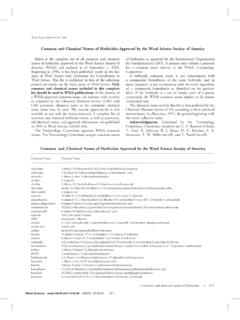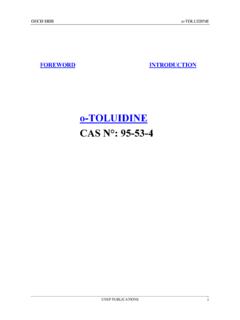Transcription of Summary of Herbicide Mechanism of Action …
1 1 Summary of Herbicide Mechanism of Action According to the Weed Science Society of America (WSSA)1 Aryloxyphenoxypropionate (FOPs) cyclohexanedione (DIMs) and phenylpyrazolin (DENs) herbicides inhibit the enzyme acetyl-CoA carboxylase (ACCase), the enzyme catalyzing the first committed step in de novo fatty acid synthesis (Burton 1989; Focke and Lichtenthaler 1987). Inhibition of fatty acid synthesis presumably blocks the production of phospholipids used in building new membranes required for cell growth. Broadleaf species are naturally resistant to cyclohexanedione and aryloxyphenoxy propionate herbicides because of an insensitive ACCase enzyme. Similarly, natural tolerance of some grasses appears to be due to a less sensitive ACCase (Stoltenberg 1989). An alternative Mechanism of Action has been proposed involving destruction of the electrochemical potential of the cell membrane, but the contribution of this hypothesis remains in , pyrimidinylthiobenzoates, sulfonylaminocarbonyltriazolinones, sulfonylureas, and triazolopyrimidines are herbicides that inhibit acetolactate synthase (ALS), also called acetohydroxyacid synthase (AHAS), a key enzyme in the biosynthesis of the branched-chain amino acids isoleucine, leucine, and valine (LaRossa and Schloss 1984).
2 Plant death results from events occurring in response to ALS inhibition and low branched-chain amino acid production, but the actual sequence of phytotoxic processes is CoA Carboxylase (ACCase) InhibitorsAcetolactate Synthase (ALS) orAcetohydroxy Acid Synthase (AHAS) InhibitorsAcetamide, chloroacetamide, oxyacetamide, and tetrazolinone herbicides (Group 15) are examples of herbicides that are currently thought to inhibit very long chain fatty acid (VLCFA) synthesis (Husted et al. 1966; B ger et al. 2000). These compounds typically affect susceptible weeds before emergence, but do not inhibit seed germination. 1523 The carbamate herbicides, carbetamide, chlorpropham, and propham (23), are examples of herbicides that inhibit cell division and microtubule organization and , benzoic acid (DCPA), dinitroaniline, phosphoramidate, and pyridine herbicides (Group 3) are examples of herbicides that bind to tubulin, the major microtubule protein.
3 The Herbicide -tubulin complex inhibits polymerization of microtubules at the assembly end of the protein-based microtubule but has no effect on depolymerization of the tubule on the other end (Vaughn and Lehnen 1991), leading to a loss of microtubule structure and function. As a result, the spindle apparatus is absent, thus preventing the alignment and separation of chromosomes during mitosis. In addition, the cell plate can not be formed. Microtubules also function in cell wall formation. Herbicide -induced microtubule loss may cause the observed swelling of root tips as cells in this region neither divide nor Inhibitors257 6 Phenylcarbamates, pyridazinones, triazines, triazinones, uracils (Group 5), amides, ureas (Group 7), benzothiadiazinones, nitriles, and phenylpyridazines (Group 6), are examples of herbicides that inhibit photosynthesis by binding to the QB-binding niche on the D1 protein of the photosystem II complex in chloroplast thylakoid membranes.
4 Herbicide binding at this protein location blocks electron transport from QA to QB and stops CO2 fixation and production of ATP and NADPH2 which are all needed for plant growth. However, plant death occurs by other processes in most cases. Inability to reoxidize QA promotes the formation of triplet state chlorophyll which interacts with ground state oxygen to form singlet oxygen. Both triplet chlorophyll and singlet oxygen can abstract hydrogen from unsaturated lipids, producing a lipid radical and initiating a chain reaction of lipid peroxidation. Lipids and proteins are attacked and oxidized, resulting in loss of chlorophyll and carotenoids and in leaky membranes which allow cells and cell organelles to dry and disintegrate rapidly. Some compounds in this group may also inhibit carotenoid biosynthesis (fluometuron) or synthesis of anthocyanin, RNA, and proteins (propanil), as well as effects on the plasmalemma (propanil) (Devine et al.)
5 1993). Photosystem II InhibitorsBenzoic acids, phenoxycarboxylic acids, pyridine carboxylic acids, and quinoline carboxylic acids (Group 4) are herbicides that act similar to that of endogenous auxin (IAA) although the true Mechanism is not well understood. The specific cellular or molecular binding site relevant to the Action of IAA and the auxin-mimicking herbicides has not been identified. Nevertheless, the primary Action of these compounds appears to affect cell wall plasticity and nucleic acid metabolism. These compounds are thought to acidify the cell wall by stimulating the activity of a membrane-bound ATPase proton pump. The reduction in apoplasmic pH induces cell elongation by increasing the activity of enzymes responsible for cell wall loosening. Low concentrations of auxin-mimicking herbicides also stimulate RNA polymerase, resulting in subsequent increases in RNA, DNA, and protein biosynthesis.
6 Abnormal increases in these processes presumably lead to uncontrolled cell division and growth, which results in vascular tissue destruction. In contrast, high concentrations of these herbicides inhibit cell division and growth, usually in meristematic regions that accumulate photosynthate assimilates and Herbicide from the phloem. Auxin-mimicking herbicides stimulate ethylene evolution which may in some cases produce the characteristic epinastic symptoms associated with exposure to these Auxins8 16 Benzofuranes (WSSA Group 16), phosphorodithioates (Group 8), and thiocarbamates (Group 8) are examples of herbicides that are known inhibitors of several plant processes including: 1) biosynthesis of fatty acids and lipids which may account for reported reductions in cuticular wax deposition, 2) biosynthesis of proteins, isoprenoids (including gibberellins), and flavonoids (including anthocyanins), and 3) gibberellin synthesis inhibition which may result from the inhibition of kaurene synthesis.
7 Photosynthesis also may be inhibited (Gronwald 1991). A currently viable hypothesis that may link all these effects involves the conjugation of acetyl coenzyme A and other sulfhydryl-containing biomolecules by thiocarbamate sulfoxides (Casida 1974; Fuerst 1987). The sulfoxide forms may be the active herbicides (Ashton and Crafts 1981).Fatty Acid and Lipid Biosynthesis InhibitorsSummary of Herbicide Mechanism of Action According to WSSA 3 Summary of Herbicide Mechanism of Action According to WSSA Glycines (glyphosate) are herbicides that inhibit 5-enolpyruvylshikimate-3-phosphate (EPSP) synthase (Amrhein 1980) which produces EPSP from shikimate-3-phosphate and phosphoenolpyruvate in the shikimic acid pathway. EPSP inhibition leads to depletion of the aromatic amino acids tryptophan, tyrosine, and phenylalanine, all needed for protein synthesis or for biosynthetic pathways leading to growth.
8 The failure of exogenous addition of these amino acids to completely overcome glyphosate toxicity in higher plants (Duke and Hoagland 1978; Lee 1980) suggests that factors other than protein synthesis inhibition may be involved. Although plant death apparently results from events occurring in response to EPSP synthase inhibition, the actual sequence of phytotoxic processes is Enolpyruvyl Shikimate-3-Phosphate (EPSP) Synthase InhibitorsCarotenoid Biosynthesis InhibitorsPhosphinic acids (glufosinate and bialophos) inhibit activity of glutamine synthetase (Lea 1984), the enzyme that converts glutamate and ammonia to glutamine. Accumulation of ammonia in the plant (Tachibana 1986) destroys cells and directly inhibits photosystem I and photosystem II reactions (Sauer 1987). Ammonia reduces the pH gradient across the membrane which can uncouple Glutamine Synthetase InhibitorsCallistemones, isoxazoles, pyrazoles, and triketones (Group 27) are examples of herbicides that inhibit p-hydroxyphenyl pyruvate dioxygenase (HPPD), which converts p-hydroxymethyl pyruvate to homogentisate.
9 This is a key step in plastoquinone biosynthesis and its inhibition gives rise to bleaching symptoms on new growth. These symptoms result from an indirect inhibition of carotenoid synthesis due to the involvement of plastoquinone as a cofactor of phytoene , anilidex, furanones, phenoxybutan-amides, pyridiazinones, and pyridines (Group 12) are examples of compunds that block carotenoid biosynthesis by inhibition of phytoene desaturase (Bartels and Watson 1978; Sandmann and B ger 1989). Carotenoids play an important role in dissipating the oxidative energy of singlet O2 (1O2). In normal photosynthetic electron transport, a low level of photosystem II reaction center chlorophylls in the first excited singlet state transform into the excited triplet state (3 Chl). This energized 3 Chl can interact with ground state molecular oxygen (O2)to form 1O2.
10 In healthy plants, the energy of 1O2 is safely quenched by carotenoids and other protective molecules. Carotenoids are largely absent in fluridone-treated plants, allowing 1O2 and 3 Chl to abstract a hydrogen from an unsaturated lipid ( membrane fatty acid, chlorophyll) producing a lipid radical. The lipid radical interacts with O2 yielding a peroxidized lipid and another lipid radical. Thus, a self-sustaining chain reaction of lipid peroxi dation is initiated which functionally destroys chlorophyll and membrane lipids. Proteins also are destroyed by 1O2. Destruction of integral membrane components leads to leaky membranes and rapid tissue 11 27 13 4 Summary of Herbicide Mechanism of Action According to WSSA Several herbicides have been identified as having an unknown mode of Action including organic arsenicals (Group 17), arylaminopropionic acids (Group 25), and other non-classified herbicides (Group 26).





